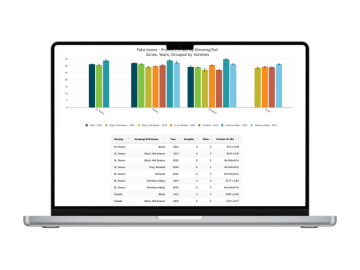
The AGGI Project: Accelerated Genetic Gain and Improvement
Activity 9 - Pulse Science Cluster Update
Jul 01, 2025

Principal Investigators — Dr. Jamie Larsen, research scientist with Agriculture and Agri-Food Canada Harrow Research and Development Centre, and Don Smith, Distinguished James McGill Professor at McGill University with Valerio Hoyos-Villegas, assistant professor in the Department of Plant, Soil and Microbial Sciences at Michigan State University
“Can we incorporate disease resistance and nitrogen-use efficiency into dry bean cultivars to improve dry bean production for Canadian farmers?” This is the question research-lead Jamie Larsen and his colleagues Dr. Anfu Hou and Dr. Ahmed Abdelmagid at Agriculture and Agri-Food Canada (AAFC) are working to answer. This research is a continuation of a Cluster 3 research activity.
The Pulse Science Cluster (the Cluster) is a cost-shared initiative under the federal government’s Sustainable Canadian Agricultural Partnership. Through the Cluster, research is funded that aims to advance the profitability and resilience of pulse growers by addressing key challenges in pulse production and developing new variety options. The AGGI Project aims to improve dry bean disease resistance and the Canadian seed production system creating more opportunities for producers.
With approximately 20,000 plots across three locations and 12 acres of field space, Dr. Larsen is enthusiastic about predicting bacterial blight symptoms and sharing the results of nitrogen-efficiency research with farmers. While pinpointing the regions of the genome with novel resistance to bacterial blight may take more years, Dr. Larsen and his team have amassed significant genetic data. Furthermore, Dr. Larsen is successfully developing germplasm to expand breeding programs, stating, “Improvement of dry bean disease resistance and the Canadian seed production system will reduce the cost of production and risk to producers.”
Canadian Bacterial Blight Resistance Research
Bacterial blight in dry bean production is a significant issue and threat to the production system. Because bacterial blights are primarily seed-borne, most dry bean seed production occurs under disease-free conditions in the semi-arid environment of Idaho in the United States. This adds significant cost to dry bean producers.
Dr. Larsen and his team, along with Dr. Nicholas Larkan at AAFC Saskatoon, are selecting a ‘panel’ of 250 genetically diverse dry bean cultivars from breeding programs, including Dr. Parthiba Balasubramanian’s program at AAFC Lethbridge and Dr. Hou’s program at AAFC Morden, and the Canadian Genebank to test for resistance to bacterial blight. Several years of testing are required before they have a solid dataset to find regions of the genome that might have novel resistance to bacterial blights.
For the 2025 growing season, Dr. Larsen will continue working towards creating a predictive model to forecast the onset of bacterial blight symptoms in crops. In conjunction with the Canadian Food Inspection Agency, he’s working on methods to assess the bacterial load in dry bean seeds. Dr. Larsen is enthusiastic about trying this innovative approach, stating, “This is a new research area for us with a different set of protocols. "
Germplasm Development
Developing germplasm with enhanced resistance traits and crossing of elite dry bean cultivars and/or varieties from the AAFC Harrow breeding program that are high yield and have good canning quality traits and novel breeding lines not widely used for breeding purposes in the AAFC Harrow breeding program will expand the program, allowing researchers to study further resistance to bacterial, fungal, and viral pathogens. Dr. Hou and Dr. Larsen are developing pinto, navy, black, kidney and cranberry bean cultivars with disease-resistance traits.
“From a breeding perspective, we’ve made double the number of crosses this year than in my six previous years with the program,” states Larsen. “These crosses are designed to build the program based to be able to study a number of research questions like bacterial blights and other diseases as well as meet the needs of farmers in Ontario and Manitoba as well as Eastern Canada.”
Nitrogen Use Efficiency
Although legumes like dry beans can fix nitrogen, nitrogen is still routinely applied to dry beans. Reducing nitrogen inputs could reduce costs and lessen the crop's environmental footprint. Larsen and his team are sending two years of data for 'nitrogen derived from the atmosphere' for testing to determine how much nitrogen in the seed was from soil versus fixed from the atmosphere. The results will inform farmers about reducing nitrogen inputs and identify current varieties that require less nitrogen or fix nitrogen more effectively.
“The first year, we didn’t see a large difference between low-nitrogen and ‘recommended’ nitrogen applications,” states Dr. Larsen. “But we found a consistent yield increase when nitrogen was applied in 2024, with the magnitude of that difference differing by variety, and that’s what’s interesting.”
Conclusion
As Dr. Larsen and his team reach the halfway mark of the AGGI Project: Accelerated Genetic Gain and Improvement, they have made significant progress in collecting both genetic and nitrogen use efficiency data. In addition, their work in germplasm development supports breeding dry bean cultivars with disease resistance and nitrogen-use efficiency. Addressing challenges such as bacterial blight, they’re employing new methods to predict disease symptoms. Their findings are poised to inform Canadian farmers about reducing nitrogen inputs and providing varieties with superior resistance traits.
Sign Up for Our Pulse Insider Newsletter
Our bi-monthly newsletter provides growers with timely, quick reads on the latest industry news and Pulse Canada’s work around the world.
Pulse Canada is the national association of growers, traders and processors of Canadian pulses, also known as lentils, dry peas, beans and chickpeas. Pulses are an essential part of a healthy and sustainable diet. Pulses and pulse ingredients can help food manufacturers improve the nutritional and functional quality of food products.


